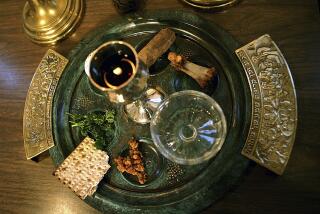The Message of Matzo
- Share via
In its plainness and simplicity, matzo reminds Jews of harsher times. But it is also a symbol of joy: It represents the Jews’ ancient flight to freedom.
Their flight from slavery in Egypt was so sudden that there wasn’t time to let the bread rise, so they packed unleavened bread.
The urgency of the Exodus and the people’s suffering in the desert are evoked in each bite of matzo, partly because eating it tends to make one thirsty. But more than that, matzo brings the past alive.
On the first night of the holiday, matzo is at the center of the Seder ceremony. At the top of the Seder plate are three matzos, representing, among other things, the three religious divisions of the early Israelites: the Kohenim (priests), the Levites (priestly assistants) and the Israelites (the people).
The middle matzo is broken in two pieces during the ceremony, and the larger piece is hidden. The remaining matzos are later elevated, and their significance is described. The matzos are offered to all at the Seder and are consumed, some plain, some with bitter herbs to remember past sufferings.
As the evening comes to a close, the hidden piece of matzo is called for. It is usually supplied by a child, for either a prize or a small ransom. This piece of matzo, known as the afikomen, represents the conclusion of the meal.


